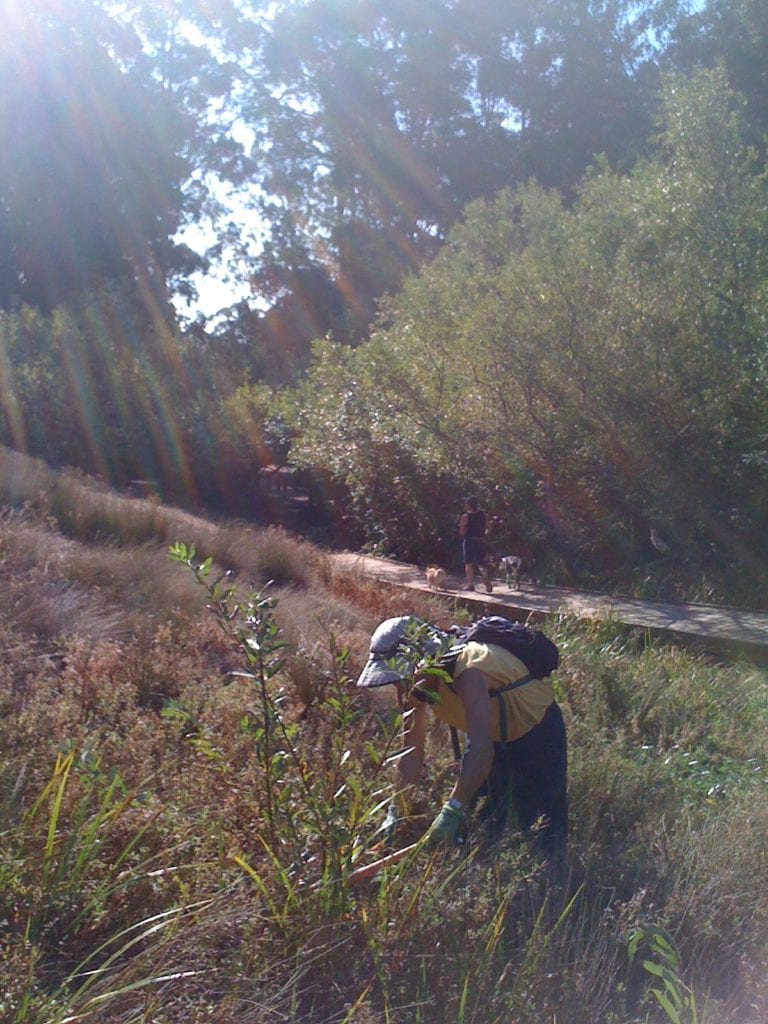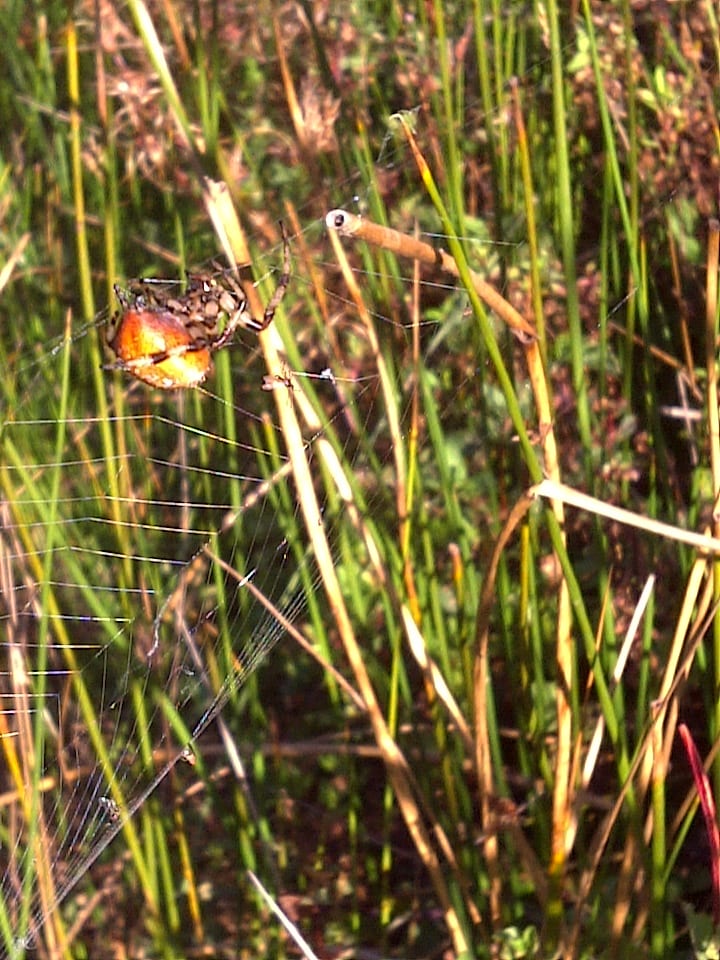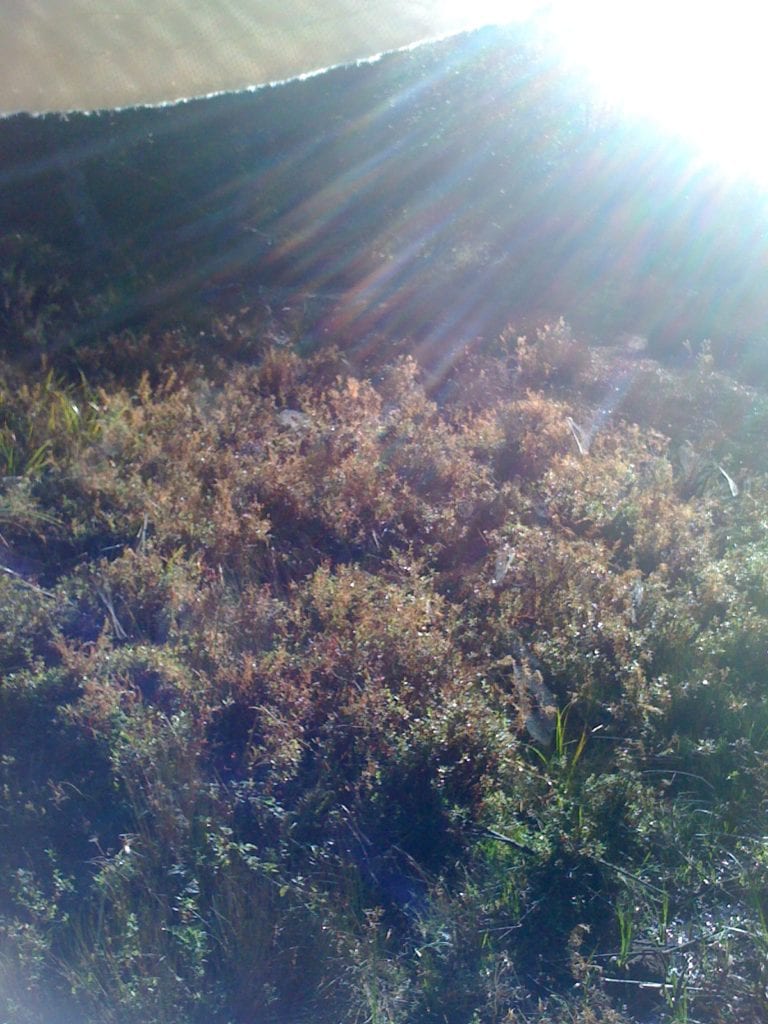
Scenes from the Glen Canyon seep

By Murray Schneider
An October sun shone over a quiver of willow sprouts adjacent to the boardwalk leading to Willow Loop Trail, which runs by a hillside seep in the heart of Glen Canyon. On a morning when Glenridge nursery school children played across Islas Creek, Jenny Sotelo, a Recreation and Parks Natural Areas Program staff member, supervised Steve Uchida and Kay Westerberg, two Friends of Glen Canyon Park volunteers.
Each stood in the marshy seep. Sotelo directed them to encroaching willow branches several yards above the latticed walkway, then modeled how to make correct cuts close to each stem, how to clump leafy stalks together, and finally how to carry each to the edge of the seep where they’d eventually decompose.

Willow is abundant in the canyon and thrives in watery places. Uchida is a retired postal worker who lives across from BART and volunteers his time on Wednesday mornings. Westerberg is a retired San Francisco middle school teacher who lives on Chenery Street and also volunteers each Wednesday.
Willow is refuge for roosting birds at the seep’s edges and napping coyotes elsewhere in the canyon’s 70 acres. Uchida and Westerberg were instructed not to remove trees, only to turn their attention to willow suckers festooned to limbs, which look like quills protruding from a porcupine. “We can preserve this sensitive wetland habitat,” said Christopher Campbell, a NAP staff member who often works with Jenny Sotelo above the 80-foot boardwalk, “by trimming wet meadow willow as necessary.”
The Glen Canyon seep, which collects run off from slopes below Diamond Heights, remains one of the few places in San Francisco that boasts above ground-pooled water. Most City water runs through culverts. The canyon seep is a biological treasure trove, home to water parsley, juncas, wax myrtle, California blackberry, ferns, sedges and rushes and, at this time of year, web-weaving pumpkin spiders.
It is a freshwater laboratory, a verdant crossroads attracting birds, insects, arachnids, rodents and amphibians, and the only place in San Francisco where yellow-eyed grass thrives as this grass grows 99% of the time only in natural conditions that exist in wetlands.
“This grass needs a specific watery habitat,” said Richard Craib, who served as president of Friends of Glen Canyon Park and who supervised the construction of a metal barrier around the grass, only inches from the boardwalk. “The fence is here to safeguard existing yellow-eyed populations.”
Given its creek-side environment, Arroyo willow, which drinks water in thirsty gulps, finds a hospitable home along Islais Creek, the second longest above ground creek in San Francisco. Community-based stewards such as Uchida and Westerberg spend hours pruning colonizing limbs that intrude along the seep’s sylvan frontiers, doing their part to ensure the preservation a 60-foot by 80-foot sanctuary, a tiny part of a park that District 8 Supervisor Scott Wiener calls “a neighborhood gem.”
Their routine maintenance, which never occurs during bird nesting season, makes it easier for park users to hike without fear of colliding into overhanging branches or jousting with thorny Himalayan blackberry stalks that peek through leaves. While Sotelo, Uchida and Westerberg bent their backs to the task, several day-trippers walked by, stopping to watch as the trio hauled armloads of twigs to a burgeoning compost heap.
“I just saw skunks,” announced Carolyn Deacy, who serves as the Glen Park Association vice president and lives on Chenery Street. She’d just completed her morning constitutional, which took her high above the canyon, close to Christopher Playground from where, if she’d looked back, she could see pillows of willow carpeting the valley floor. Skunks, raccoons and gophers abound in the canyon and one needn’t take Deacy’s word for it. The presence of a laser-eyed Red-tailed hawk perched on a tree above the seep, scouting for a meal provided more than ample evidence.
A woman walking her dog trailed behind Deacy. She looked at workers and volunteered she’d dropped her Ray-Bans. “Anyone find a pair of sunglasses?” she asked. Sotelo stopped what she was doing. She said she didn’t, but would bring them to the Recreation Center if she found them.
 Bookended by two parents, Glenridge children walked by next. A father looked over his shoulder. “Come on everyone,” he said, crooking his finger at stragglers, “we’re looking for caterpillar food.” Spotting a rodent, the hawk sailed above the nursery school kids, letting out a squawk.
Bookended by two parents, Glenridge children walked by next. A father looked over his shoulder. “Come on everyone,” he said, crooking his finger at stragglers, “we’re looking for caterpillar food.” Spotting a rodent, the hawk sailed above the nursery school kids, letting out a squawk.
Gloria Koch, another volunteer, who lives on Diamond Street and who recently retired after 28 years as a Golden Gate Park manager, joined Uchida, Westerberg and Sotelo on the slope.
“The seep is part of a rich, complex habitat that includes meadows, shrubs, forests and this aquatic environment is rare in San Francisco.” Koch said. “So it is important to protect it.” Concerned about the loss of such a priceless natural resource, the Recreation and Parks Commission created the NAP in the mid-1990s to perform its role as guardian to this and other City oases, which escaped the transformation from wild land to metropolis.
Kneeling, Koch wielded a mattock, a circle of long-standing water, glass-like in its clarity, pooled next to her work pants. She began removing strands of interloping Himalayan blackberry and English ivy. “Both are invasive, encroaching and threatening the seep,” she said.
Led by instructor Rebecca Crowe, a field trip of 24 San Francisco State University students walked by, making a Haji to the marshy Mecca. The students clutched binders, scribbling notes as they walked. “This is an undergraduate class for non-botany majors,” Crowe said. “It’s called ‘World of Plants.’”
Another student skipped by, this time a four-year old pre-schooler. Henry Tuttle, accompanied by his mother, Dana, and Luxa, their seven-year old dog, stepped across the pressure-treated wood boardwalk like veterans, which they both are. “We come out here everyday,” said Dana Tuttle, who lives on Sussex Street. “Sometimes twice a day.”
“I like the beetles, “said Henry. “They’re in front of the logs.”
“He means the logs in front of Glenridge,” said Dana Tuttle. “He likes the owls, too. So do I.”
Henry, clad in a black T-shirt, emblazoned with ‘HI’ across it and wearing a pair of horned-rimmed glasses that made him look, yes, a bit owlish. He sensed he had a willing audience. “How does a seal get across a parking lot?” he asked this reporter.
The caretakers looked up, attempting to juggle the vision of a seal, a parking lot and Glen Canyon.
“With barking tickets,” smiled Henry, his comedic timing honed to a point as sharp as the Himalayan blackberry thorns the volunteers had removed only a few feet above him.
Jenny Sotelo wandered over. She asked if Henry had ever seen a pumpkin spider. Dana Tuttle shook her head. Sotelo pointed to an epilobium, a colorful plant, which thrives in the slushy seep.
Henry and his mother bent over, looking closer. Dana Tutttle fished a digital camera from her jeans. “It’s there,” pointed Henry, stowing away in his grey cells the memory of the spider tight roping on its silken-constructed web. Halloween fast approaching, Henry clearly needed additional ammunition for his arsenal of stand-up comedy material.
Overhead the hawk returned from its hunting foray and settled in a willow branch. A humming bird flew within a shoulder’s length of the raptor, hovering next to it, ignoring any possible threat. A volunteer returned from stuffing branches, butt first, into a patch of decomposing boughs at the end of the boardwalk, his right shoe now a suction-cup of mud and both his cuffs candidates for the family Maytag. The spider played possum, hoodwinking unsuspecting insects onto its trampoline, possibly one of Henry’s beetles. An unleashed dog padded off the boardwalk and sniffed bulrushes, ignoring its minder’s shouted protestations and the raised eyebrows of the volunteers.
“Glen Canyon’s is the best-kept secret,” of San Francisco, said Dana Tuttle about an irreplaceable aquatic community only blocks from her doorstep. The morning’s busy traffic surely put to rest such a shibboleth, and while the canyon seep isn’t as scarce as the Hope Diamond, it remains a precious jewel in Glen Canyon’s crown.
“To have access to natural pools of water is a privilege for the visitor, not only to enjoy wildlife diversity but for the whole experience of its beauty,” said Gloria Koch. She gathered her tools and, along with Uchida, Westerberg and Sotelo, prepared to turn to another task, this time collecting native plant seeds from the slopes where Carolyn Deacy had earlier kept a healthy distant from milling skunks.
Henry Tuttle, who’d just experienced both wildlife and beauty, took his mother’s hand, regained the boardwalk and with Luxa in tow, headed back to Elk Street for their walk up the hill to Sussex Street. If history repeats itself, Henry and him mom would be back again that afternoon, experiencing it all over again.
Before departing, Koch appraised the incomparable seep, rich in biodiversity, fixing on a matrix of filaments, home to dozens and dozens of October pumpkin spiders. “We want to give people a park experience that is close to nature,” she said. “Anyone can have a magic moment here when they feel they’re part of the web-of-life.”
And anyone who wishes to volunteer with Friends of Glen Canyon, under its supervision by the Natural Areas Program, can contact Joe Grey, NAP volunteer coordinator, at joe.grey@sfgov.org or 415-831-6328 or Jean Conner, Friends of Glen Canyon Park, at 415-584-8576.

